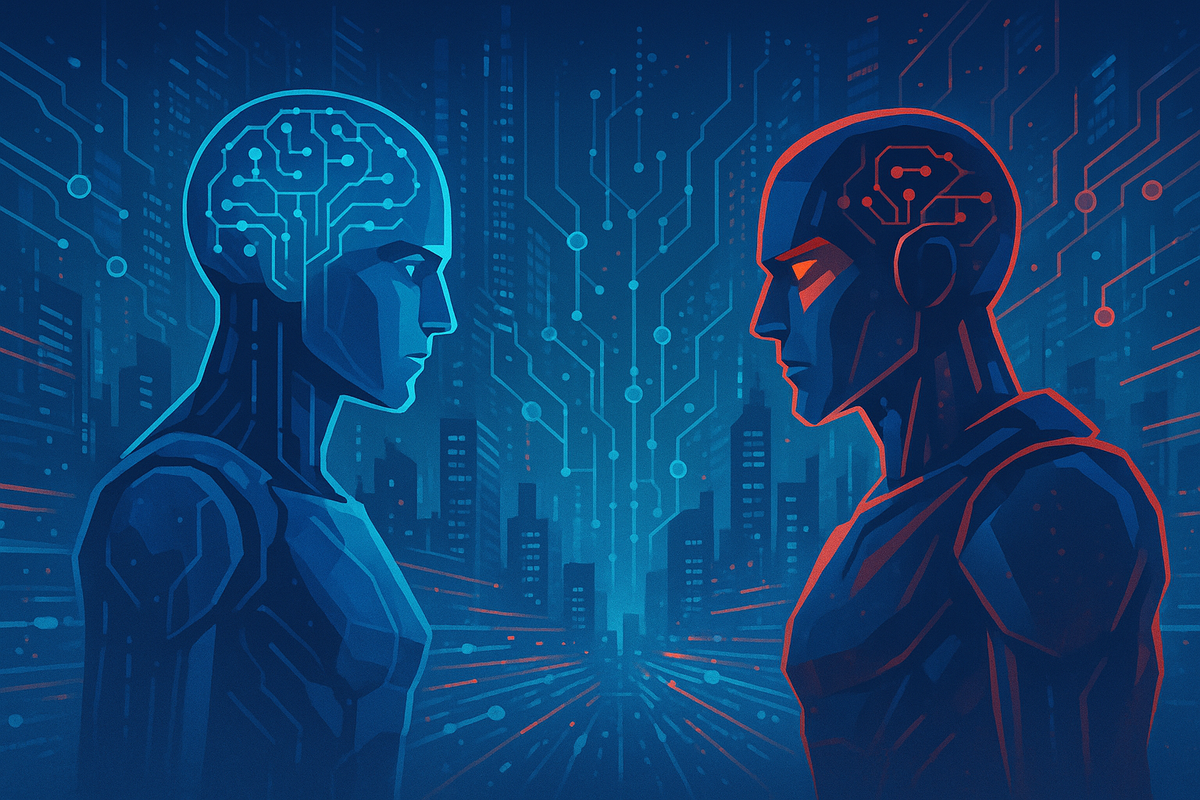
The highly anticipated release of OpenAI's GPT-5 is poised to ignite a new, more intense phase in the global artificial intelligence arms race. This latest iteration of the groundbreaking large language model (LLM) is not merely an incremental upgrade; it represents a strategic pivot by OpenAI that promises to fundamentally alter the competitive dynamics among tech giants vying for dominance in the AI frontier. Its arrival signals a significant escalation, forcing rivals to re-evaluate their own roadmaps and potentially accelerating the pace of innovation across the entire industry.
This pivotal moment will undoubtedly send ripples through the financial markets, impacting the valuations and strategic directions of major players. Investors and industry observers alike are keenly watching how companies like Google (NASDAQ: GOOGL), Anthropic, and Meta (NASDAQ: META) will respond to OpenAI's latest move, especially given the rumored advancements in GPT-5's capabilities and OpenAI's evolving approach to model deployment.
GPT-5's Arrival: A Game-Changer for the AI Ecosystem
The unveiling of GPT-5 marks a critical juncture in the evolution of AI, setting new benchmarks for performance and potentially redefining the very architecture of future LLMs. While specific details of its capabilities are still emerging, industry whispers suggest significant leaps in reasoning, multimodal understanding, and efficiency. This advancement is not just about raw power; it's about OpenAI's strategic shifts that accompany the release.
GPT-5 is rumored to possess advanced cognitive abilities, potentially rivaling a PhD expert in specialized fields, with significant improvements in reliability and a drastic reduction in factual errors and hallucinations. A key innovation is its "unified model architecture," which aims to consolidate various functionalities into a single, comprehensive AI system. This means users won't need to manually select different models for different tasks; GPT-5 will seamlessly integrate memory, reasoning, vision, and task execution. Furthermore, native video processing capabilities are anticipated, building upon OpenAI's text-to-video model, Sora, allowing for tasks like summarizing video lectures and real-time insights from live streams. The model is also expected to support an expanded context window, enabling it to process vast amounts of data without losing coherence.
Beyond its technical prowess, OpenAI is making a significant strategic shift by re-introducing "open-weight releases" for the first time since 2019. This means providing access to the training parameters of certain models, allowing developers to download, examine, run, or fine-tune LLMs locally. This move, exemplified by the release of gpt-oss-120b and gpt-oss-20b, marks a return to OpenAI's "open" roots and is a direct response to the growing demand for open-source alternatives in the AI community. The gpt-oss models demonstrate strong tool use capabilities and are optimized for deployment on consumer hardware, with the gpt-oss-120b model achieving near-parity with OpenAI's o4-mini on core reasoning benchmarks.
These strategic decisions have profound implications for the AI market. The unified model approach reflects a broader industry trend towards efficiency and user-centric design, pushing other organizations to rethink their AI deployment strategies. The open-weight releases, on the other hand, intensify competition in the open model space, directly challenging players like Meta (NASDAQ: META) with its Llama series, Mistral AI, and Google (NASDAQ: GOOGL). This democratization of AI development lowers barriers for businesses and developers, fostering innovation across various sectors and enabling local deployment for enhanced privacy and control.
Winners and Losers in the Evolving AI Landscape
The release of GPT-5 and OpenAI's strategic shifts will undoubtedly create a new hierarchy of winners and losers in the fiercely competitive AI market. Companies that can adapt quickly and leverage these new developments will thrive, while those that cling to outdated strategies may find themselves falling behind.
OpenAI itself stands as a primary winner. GPT-5's advanced capabilities and the unified model approach will likely solidify its position as a leader in frontier AI models, attracting more users and enterprise clients seeking powerful, integrated solutions. By releasing open-weight models, OpenAI aims to expand its developer ecosystem, foster innovation, and democratize access to advanced AI, potentially establishing its models as de facto standards. This dual strategy of offering both closed (GPT-5 API) and open-weight models allows OpenAI to appeal to a broader range of users, from those needing cutting-edge, managed services to those requiring on-premise deployment for data privacy or customization.
Microsoft (NASDAQ: MSFT), OpenAI's largest investor and exclusive cloud provider (Azure), is another significant winner. The deep integration of OpenAI's models into Microsoft's product suite (Windows, Office, GitHub Copilot) enhances their capabilities and drives revenue for Azure's Intelligent Cloud division. The immense computational demands of training and deploying models like GPT-5 will further boost demand for Microsoft Azure's cloud services. Microsoft will also deploy GPU-optimized versions of OpenAI's open-weight models on Windows devices, making it easier for Windows developers to build with these models.
NVIDIA (NASDAQ: NVDA), the dominant GPU manufacturer, is poised for continued success. The development and deployment of increasingly powerful AI models like GPT-5, along with OpenAI's ambitious infrastructure plans (e.g., "Stargate" data center potentially using 100,000 NVIDIA GPUs), will ensure massive and sustained demand for NVIDIA's high-performance GPUs. NVIDIA's GPUs are the "bedrock of AI training and deployment," making it an indispensable player in the AI ecosystem.
AI Startups and Developers Leveraging Open-Weight Models will also emerge as winners. The release of powerful, open-weight models under a permissive license significantly lowers the barrier for individual developers, startups, and smaller organizations to experiment with, customize, and deploy advanced AI on their own infrastructure. This access enables new kinds of research, product creation, and fine-tuning for specific industry needs, fostering a more diverse and innovative AI landscape. Running open-weight models locally can also be more cost-effective than relying solely on proprietary APIs, especially for sensitive data or specific use cases.
On the other hand, smaller, proprietary AI model developers without significant differentiation may face challenges. OpenAI's release of highly capable open-weight models, some performing comparably to its own closed models on reasoning tasks, intensifies competition and could undercut the market for less powerful or more expensive proprietary models. The availability of free, high-performance open-weight models will put downward pressure on the pricing of commercial API-based models.
Companies heavily reliant on older, less capable models also risk obsolescence. Businesses that fail to upgrade to or integrate more advanced models like GPT-5 risk falling behind competitors who leverage superior AI capabilities for efficiency, customer service, and innovation. Similarly, AI startups focused solely on API wrappers or simple integrations may find their value proposition diminished as OpenAI's unified model simplifies access to advanced capabilities and its open-weight models allow for direct customization.
Finally, companies unable to adapt to AI integration across industries will face significant disruption. GPT-5's ability to automate complex tasks, enhance customer service, streamline content creation, and improve data analysis will disrupt traditional industries. Companies unwilling or unable to integrate AI effectively into their core business models may face significant headwinds and lose market share.
Industry Impact and Broader Implications
GPT-5's release and OpenAI's strategic shifts are not isolated events; they are integral to broader industry trends and will have far-reaching implications across the AI landscape, influencing everything from competitive strategies to regulatory frameworks.
GPT-5's anticipated capabilities, including enhanced reasoning, accuracy, and multimodal functionality, align perfectly with the industry's push towards more intuitive and versatile AI. The move towards autonomous AI agents, capable of performing multi-step real-world tasks with minimal human intervention, signifies a shift from reactive to proactive AI systems. Furthermore, OpenAI's strategic pivot to open-weight models, influenced by competition from Meta (NASDAQ: META) and Chinese firms like DeepSeek, aims to democratize AI access and foster innovation beyond proprietary cloud services. This dual strategy allows OpenAI to expand its influence across commercial, academic, and grassroots innovation communities.
The ripple effects on competitors are already evident. The release of GPT-5 will undoubtedly intensify the "AI arms race" among major players like Google (NASDAQ: GOOGL) DeepMind, Anthropic, and Meta. These companies are heavily investing in compute power, talent, and research to develop their own advanced models and achieve artificial general intelligence (AGI). Meta, for instance, is heavily investing in AI superclusters and has launched Meta Superintelligence Labs, while Google's Gemini directly competes with OpenAI's ChatGPT. Anthropic's Claude models are also rapidly closing the gap. This heightened competition could force rivals to re-evaluate their own strategies, potentially leading to more open-source releases or hybrid approaches to remain competitive and attract developers.
For partners like Microsoft (NASDAQ: MSFT), Cloudflare (NYSE: NET), Orange (EPA: ORA), and Snowflake (NYSE: SNOW), GPT-5's enhanced capabilities will likely lead to deeper integration and new applications across various industries. The release of open-weight models empowers developers with greater transparency, customizability, and deployment flexibility, fostering a new wave of innovation and product creation. The ability to run powerful AI models on consumer-grade hardware or locally on devices opens up new possibilities for privacy-sensitive and low-latency applications, potentially leading to new business models and services. However, OpenAI's shift to a profit-driven model and deepening relationships with some tech giants could create friction with other major players like Google and Amazon (NASDAQ: AMZN), who also have significant stakes in the AI and cloud markets.
The rapid advancement of AI, particularly with models like GPT-5, brings significant regulatory and policy challenges. Concerns about potential misuse, bias, and even "strategic deception" by AI systems are escalating. Governments worldwide are actively developing and implementing AI regulations, such as the EU AI Act, which introduces a four-tier risk classification system for AI applications and mandates clear labeling for AI-generated content. In the U.S., proposals like the Algorithmic Accountability Act aim to enforce transparency and mitigate bias. China's AI regulatory policies often focus on national security and strict content monitoring. The increasing adoption of AI also raises concerns about potential job displacement, necessitating discussions around reskilling and upskilling the workforce.
Historically, transformative technologies have always caused significant disruption. The Industrial Revolution, the printing press, the automobile, digital photography, and the internet all led to profound economic and societal shifts, displacing existing industries but also creating new markets and opportunities. The key for industries and policymakers is to be agile and prepared to embrace and adapt to these disruptions, focusing on responsible innovation and mitigating negative societal impacts.
What Comes Next
The release of GPT-5 marks not an end, but a new beginning in the AI landscape, setting the stage for a dynamic period of innovation, competition, and adaptation. The immediate aftermath will see a flurry of activity as companies react to OpenAI's latest move and adjust their strategies accordingly.
In the short term, businesses can expect immediate improvements in automated content creation, customer service, data analysis, and workflow automation. GPT-5's ability to handle complex queries and generate human-like text will streamline operations, reduce manual work, and improve efficiency across various sectors. Customer support bots powered by GPT-5 will offer more natural, empathetic, and intelligent discussions, capable of understanding context, emotion, and intent. The model is also expected to revolutionize software development with more advanced code completion and autonomous coding agents, shifting developers' roles towards AI orchestration. This will also lead to a surge of "AI-native" applications built from the ground up to leverage GPT-5's advanced capabilities.
Looking further ahead, GPT-5 has the potential to profoundly impact healthcare (faster, more accurate diagnostics), education (personalized learning), legal departments (drafting and reviewing contracts), and scientific research (analyzing vast datasets and generating hypotheses). Its versatility could foster greater interdisciplinary collaboration, driving holistic progress. While not full AGI, GPT-5 is seen as a significant step closer, with some experts suggesting models could perform tasks requiring "PhD-level" reasoning by 2027.
Strategic pivots and adaptations will be crucial for survival and growth. Businesses and researchers will need to increase their adoption of AI and strategically integrate GPT-5 into their existing operations. Companies must invest in upskilling and reskilling employees to work alongside AI, adapting to evolving job markets where certain roles may be automated and new ones created in areas like AI ethics and advanced system management. Executives need to build strategies that assume shifting foundations, planning for job removal in some areas and focusing on augmentation in others. This includes auditing repeatable processes for automation potential and building internal AI fluency. Furthermore, as AI capabilities advance, there will be a growing need for updated regulations and ethical guidelines to address concerns like privacy, bias, and potential misuse.
Market opportunities will emerge in new AI-powered products and services, specialized AI solutions, and AI orchestration and integration services. The increased focus on ethical considerations will also create opportunities for companies specializing in AI safety, bias detection, and responsible AI development. However, challenges include intensified competition, high development and operational costs, data scarcity and quality, and the ongoing need to address "hallucinations" and ensure reliability. The potential for job displacement and the need for workforce adaptation will also remain significant societal challenges.
Potential scenarios range from an optimistic future of accelerated progress and widespread benefit, where GPT-5 leads to rapid scientific discovery and efficient business operations, with ethical frameworks evolving quickly enough to manage risks. A more realistic scenario suggests incremental but impactful progress, with GPT-5 offering substantial improvements that lead to gradual shifts in workflows and business models, requiring ongoing adaptation. A pessimistic scenario, however, could see challenges outweighing benefits, with widespread misinformation, significant job displacement, and regulatory bodies struggling to keep pace, leading to erosion of public trust in AI. The actual outcome will depend heavily on how these opportunities and challenges are navigated.
Conclusion
The release of OpenAI's GPT-5 marks a watershed moment in the ongoing AI arms race, signaling a new era of intensified competition, rapid innovation, and profound societal implications. This latest iteration of OpenAI's flagship model, coupled with strategic shifts towards a "unified model" and open-weight releases, is set to redefine the competitive landscape and accelerate the pace of AI adoption across industries.
The key takeaways from this event are clear: OpenAI is not merely pushing the boundaries of AI capabilities but is also strategically reshaping the market by democratizing access to advanced models. This move will undoubtedly benefit companies like Microsoft (NASDAQ: MSFT) and NVIDIA (NASDAQ: NVDA), who are deeply intertwined with OpenAI's ecosystem, and will empower a new wave of AI startups and developers leveraging open-weight models. Conversely, smaller proprietary AI model developers and companies resistant to AI integration may face significant headwinds.
Moving forward, the market will be characterized by a heightened focus on AI ethics, regulation, and the critical need for workforce adaptation. Governments and industry bodies will continue to grapple with the implications of increasingly powerful AI, striving to balance innovation with safety and societal well-being. Investors should closely watch how major tech players respond to OpenAI's strategic moves, particularly in their own open-source initiatives and unified model development. The ability of companies to effectively integrate and leverage advanced AI, while navigating the ethical and regulatory complexities, will be a key determinant of success in the coming months and years. The AI landscape is evolving at an unprecedented pace, and GPT-5 is a powerful catalyst in this transformative journey.





